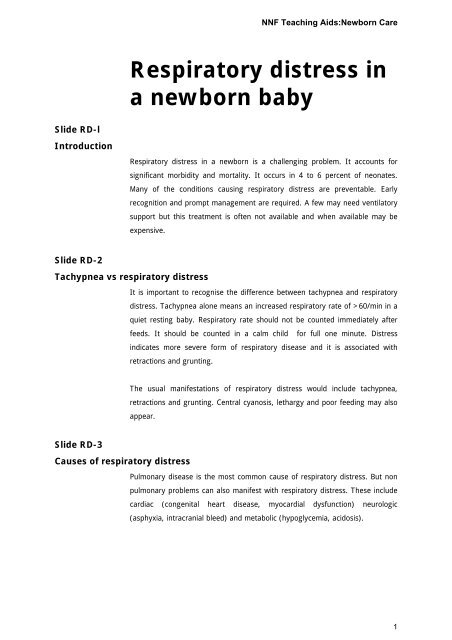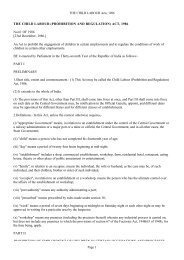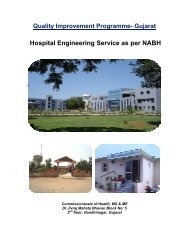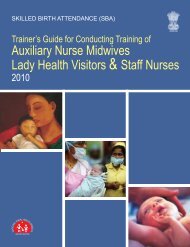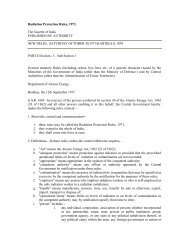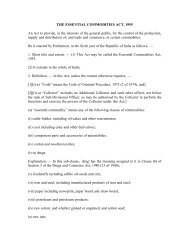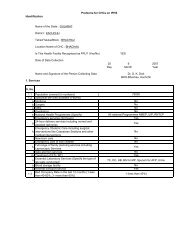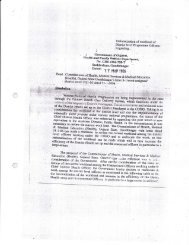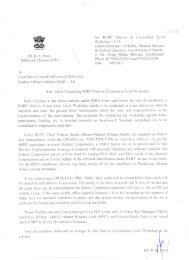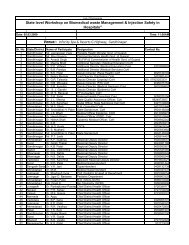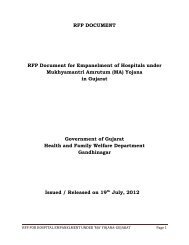Respiratory distress in - Newbornwhocc.org
Respiratory distress in - Newbornwhocc.org
Respiratory distress in - Newbornwhocc.org
You also want an ePaper? Increase the reach of your titles
YUMPU automatically turns print PDFs into web optimized ePapers that Google loves.
NNF Teach<strong>in</strong>g Aids:Newborn Care<br />
<strong>Respiratory</strong> <strong>distress</strong> <strong>in</strong><br />
a newborn baby<br />
Slide RD-l<br />
Introduction<br />
<strong>Respiratory</strong> <strong>distress</strong> <strong>in</strong> a newborn is a challeng<strong>in</strong>g problem. It accounts for<br />
significant morbidity and mortality. It occurs <strong>in</strong> 4 to 6 percent of neonates.<br />
Many of the conditions caus<strong>in</strong>g respiratory <strong>distress</strong> are preventable. Early<br />
recognition and prompt management are required. A few may need ventilatory<br />
support but this treatment is often not available and when available may be<br />
expensive.<br />
Slide RD-2<br />
Tachypnea vs respiratory <strong>distress</strong><br />
It is important to recognise the difference between tachypnea and respiratory<br />
<strong>distress</strong>. Tachypnea alone means an <strong>in</strong>creased respiratory rate of >60/m<strong>in</strong> <strong>in</strong> a<br />
quiet rest<strong>in</strong>g baby. <strong>Respiratory</strong> rate should not be counted immediately after<br />
feeds. It should be counted <strong>in</strong> a calm child for full one m<strong>in</strong>ute. Distress<br />
<strong>in</strong>dicates more severe form of respiratory disease and it is associated with<br />
retractions and grunt<strong>in</strong>g.<br />
The usual manifestations of respiratory <strong>distress</strong> would <strong>in</strong>clude tachypnea,<br />
retractions and grunt<strong>in</strong>g. Central cyanosis, lethargy and poor feed<strong>in</strong>g may also<br />
appear.<br />
Slide RD-3<br />
Causes of respiratory <strong>distress</strong><br />
Pulmonary disease is the most common cause of respiratory <strong>distress</strong>. But non<br />
pulmonary problems can also manifest with respiratory <strong>distress</strong>. These <strong>in</strong>clude<br />
cardiac (congenital heart disease, myocardial dysfunction) neurologic<br />
(asphyxia, <strong>in</strong>tracranial bleed) and metabolic (hypoglycemia, acidosis).<br />
1
NNF Teach<strong>in</strong>g Aids:Newborn Care<br />
Slide RD-4, 5<br />
Causes of respiratory <strong>distress</strong><br />
<strong>Respiratory</strong> <strong>distress</strong> <strong>in</strong> a newborn could be caused either by surgical or medical<br />
conditions. The common medical conditions are <strong>Respiratory</strong> <strong>distress</strong> syndrome<br />
(RDS), Meconium aspiration syndrome (MAS), Transient tachypnea of newborn<br />
(TTNB), pneumonia, aspiration, pulmonary hypertension, delayed adaptation,<br />
asphyxia and acidosis. Surgical conditions would <strong>in</strong>clude Pneumothorax,<br />
Diaphragmatic hernia, Tracheo esophageal fistula (aspiration), Pierre Rob<strong>in</strong><br />
Syndrome (upper airway obstruction due to glossoptosis), Choanal atresia and<br />
Lobar emphysema.<br />
Slide RD-6<br />
History<br />
While stabiliz<strong>in</strong>g a baby with severe respiratory <strong>distress</strong>, it is important to get a<br />
good history. We need to know the gestation and if the baby is premature it is<br />
important to know if antenatal steroids have been given or not. A history to<br />
determ<strong>in</strong>e the source of <strong>in</strong>fection would <strong>in</strong>clude history of premature rupture<br />
of membranes (PROM), if onset of <strong>distress</strong> is early. Aga<strong>in</strong> <strong>in</strong> early onset <strong>distress</strong><br />
one should f<strong>in</strong>d out the Apgar score and history of meconium sta<strong>in</strong>ed liquor.<br />
The importance of determ<strong>in</strong><strong>in</strong>g the time of onset of <strong>distress</strong> needs to be<br />
emphasized, as this may vary depend<strong>in</strong>g upon the etiology . It is important to<br />
know about the feed<strong>in</strong>g problems. Feed<strong>in</strong>g problems could be present <strong>in</strong> a<br />
severely <strong>distress</strong>ed baby. If feed<strong>in</strong>g problems are present such as chok<strong>in</strong>g or<br />
aspiration dur<strong>in</strong>g a feed, one could th<strong>in</strong>k of aspiration pneumonia as a<br />
possibility.<br />
Slide RD-7<br />
Exam<strong>in</strong>ation<br />
To assess the severity of the <strong>distress</strong> the scor<strong>in</strong>g system given <strong>in</strong> Table 1 could<br />
be used. Cl<strong>in</strong>ical monitor<strong>in</strong>g is most important. An <strong>in</strong>creas<strong>in</strong>g score is more<br />
important than just an <strong>in</strong>crease <strong>in</strong> rate. It is also important to dist<strong>in</strong>guish<br />
between tachypnea and respiratory <strong>distress</strong>. Tachypnea is usually characteristic<br />
of a disease like transient tachypnea of newborn. Cardiac conditions and<br />
acidosis also usually manifest with tachypnea but could progress on to <strong>distress</strong>.<br />
2
NNF Teach<strong>in</strong>g Aids:Newborn Care<br />
Slide RD-8<br />
Assessment of respiratory <strong>distress</strong><br />
Table 1: Score for respiratory <strong>distress</strong><br />
Score<br />
0 1 2<br />
Resp. rate 80<br />
Central cyanosis None None with 40% FiO 2 Need >40% FiO 2<br />
Retractions None Mild Severe<br />
Grunt<strong>in</strong>g None M<strong>in</strong>imal Obvious<br />
Air Entry Good Decreased Very poor<br />
A score of greater than 6 would <strong>in</strong>dicate severe respiratory <strong>distress</strong>.<br />
Slide RD-9<br />
Chest exam<strong>in</strong>ation<br />
Exam<strong>in</strong>ation of the chest could be helpful <strong>in</strong> diagnos<strong>in</strong>g the etiology. In MAS,<br />
the chest is hyper<strong>in</strong>flated. Air entry is usually decreased <strong>in</strong> severe RDS.<br />
Mediast<strong>in</strong>al shift could occur <strong>in</strong> pneumothorax or diaphragmatic hernia. Distant<br />
heart sounds could give a clue to the diagnosis of pneumothorax.<br />
Slide RD-10<br />
Approach <strong>in</strong> preterm<br />
In a preterm baby, early onset respiratory <strong>distress</strong> which is progressive is<br />
<strong>in</strong>variably due to RDS. However, if <strong>distress</strong> is transient, asphyxia, hypoglycemia<br />
and hypothermia could contribute. Other causes of <strong>distress</strong> which occur <strong>in</strong> term<br />
babies could also occur <strong>in</strong> preterm babies, but the most common and important<br />
cause <strong>in</strong> pre term babies is RDS. Pneumonia could present at anytime after<br />
birth.<br />
Slide RD-11<br />
Approach <strong>in</strong> term<br />
In term babies etiology could differ depend<strong>in</strong>g on the time of onset of <strong>distress</strong>.<br />
If the baby has tachypnea beg<strong>in</strong>n<strong>in</strong>g at birth the causes could be TTNB or<br />
secondary to polycythemia. If the <strong>distress</strong> beg<strong>in</strong>s early but is more severe it<br />
may be due to MAS, pneumonia, asphyxia or malformations.<br />
3
NNF Teach<strong>in</strong>g Aids:Newborn Care<br />
If the <strong>distress</strong> occurs at the end of first week or later the cause would be most<br />
probably pneumonia. Presence of a cleft palate, history of a chok<strong>in</strong>g episode<br />
could <strong>in</strong>dicate aspiration pneumonia. If however the baby has hepatomegaly or<br />
is <strong>in</strong> shock one needs to th<strong>in</strong>k of a cardiac cause. On the other hand if the baby<br />
is dehydrated and <strong>in</strong> shock, a possibility of metabolic acidosis needs to be<br />
considered.<br />
Slide RD-12<br />
Suspect surgical cause<br />
We need to suspect surgical conditions if there are any obvious malformations<br />
(cleft palate, micrognathia) or if there is a scaphoid abdomen (diaphragmatic<br />
hernia) . Presence of froth<strong>in</strong>g or history suggestive of aspiration may give a<br />
clue to the presence of a tracheo-esophageal fistula (TEF). Worsen<strong>in</strong>g of<br />
condition dur<strong>in</strong>g resuscitation at birth by bag and mask ventilation -th<strong>in</strong>k of<br />
diaphragmatic hernia.<br />
The common malformations/surgical conditions which could present <strong>in</strong> the<br />
neonatal period <strong>in</strong>clude TEF, diaphragmatic hernia, lobar emphysema, choanal<br />
atresia and cleft palate. It is important to recognize these conditions early as<br />
immediate referral and appropriate management would improve prognosis. A<br />
baby with suspected TEF should not be fed and a baby with suspected<br />
diaphragmatic hernia should not be resuscitated with bag and mask.<br />
Slide RD- 13,14<br />
Investigations<br />
Investigations would obviously depend on the possible etiology. If PROM is<br />
present one should look for polymorphs <strong>in</strong> the gastric aspirate. The first gastric<br />
aspirate should be used for this test and the aspirate should be clear. Shake<br />
test is a simple bedside test and should be done <strong>in</strong> preterm babies with<br />
respiratory <strong>distress</strong>. The gastric aspirate (0.5 ml) is mixed with 0.5 ml of<br />
absolute alcohol <strong>in</strong> test tube. This is shaken for 15 sec. and allowed to stand<br />
for 15 m<strong>in</strong>utes. A negative shake test i.e. no bubbles or bubbles cover<strong>in</strong>g less<br />
than 1/3 rd of the rim <strong>in</strong>dicates a high risk of develop<strong>in</strong>g RDS and the presence<br />
of bubbles at more than 2/3 of the rim <strong>in</strong>dicates lung maturity and decreased<br />
risk of develop<strong>in</strong>g RDS. Sepsis screen is <strong>in</strong>dicated if <strong>in</strong>fection is suspected. The<br />
most important <strong>in</strong>vestigation <strong>in</strong> a neonate with respiratory <strong>distress</strong> is a chest X-<br />
4
NNF Teach<strong>in</strong>g Aids:Newborn Care<br />
ray( refer RD-20 ). An arterial blood gas if available is a good adjunct to plan<br />
and monitor respiratory therapy.<br />
Slide RD-15<br />
Pr<strong>in</strong>ciples of management<br />
Supportive therapy is most crucial <strong>in</strong> all neonates with respiratory <strong>distress</strong> and<br />
the same pr<strong>in</strong>ciples apply, whatever the cause.<br />
Monitor<strong>in</strong>g is needed <strong>in</strong> all babies with respiratory <strong>distress</strong>. Cl<strong>in</strong>ical monitor<strong>in</strong>g<br />
is most important as sophisticated equipment may not be available. The<br />
scor<strong>in</strong>g system could be utilised to monitor babies. An <strong>in</strong>creas<strong>in</strong>g score would<br />
<strong>in</strong>dicate worsen<strong>in</strong>g <strong>distress</strong>.<br />
All babies with significant <strong>distress</strong> should be kept on IV fluids ; blood pressure<br />
and blood sugar should be ma<strong>in</strong>ta<strong>in</strong>ed.<br />
Other measures <strong>in</strong>clude oxygen therapy and if available ventilatory support or<br />
CPAP (cont<strong>in</strong>uous positive airway pressure). Specific therapy is now available<br />
for RDS i.e. surfactant, but even with this ventilatory support will be needed.<br />
Slide RD-16, 17<br />
Oxygen therapy<br />
All babies with worsen<strong>in</strong>g or severe respiratory <strong>distress</strong>, with or without<br />
cyanosis should get oxygen. Oxygen should be warm and humidified . It can<br />
be provided through nasal catheters or preferably through oxygen hood. The<br />
flow rate should be 2-5 L/m<strong>in</strong> (40-70% O 2 ) . Oxygen should be used with<br />
caution especially <strong>in</strong> preterm babies. Respect oxygen -it has both good and<br />
toxic effects and use it only if needed. Use lower concentration of oxygen to<br />
relieve cyanosis or <strong>distress</strong>. Pulse oximetry is a simple non-<strong>in</strong>vasive method<br />
for measur<strong>in</strong>g oxygen saturation. Ideally all neonates with respiratory <strong>distress</strong><br />
should be monitored us<strong>in</strong>g a pulse oximeter and oxygen should be<br />
adm<strong>in</strong>istered if saturations are less than 90%. Aim is to ma<strong>in</strong>ta<strong>in</strong> saturation<br />
between 90-93% to avoid hyperoxia.<br />
5
NNF Teach<strong>in</strong>g Aids:Newborn Care<br />
Slide RD-18<br />
<strong>Respiratory</strong> <strong>distress</strong> syndrome (RDS)<br />
If a preterm baby has respiratory <strong>distress</strong> with<strong>in</strong> the first 6 hrs of birth and is<br />
cyanosed or needs oxygen to ma<strong>in</strong>ta<strong>in</strong> oxygen saturation the diagnosis is RDS<br />
unless proved otherwise. X-ray f<strong>in</strong>d<strong>in</strong>gs would be a reticulo-granular pattern <strong>in</strong><br />
mild disease and a "white out" picture <strong>in</strong> severe disease.<br />
Slide RD-19<br />
X-ray show<strong>in</strong>g air bronchogram and hazy lung suggestive of HMD.<br />
Slide RD-20<br />
Pathogenesis<br />
The basic problem <strong>in</strong> a preterm baby with RDS is surfactant deficiency.<br />
Surfactant is needed to decrease alveolar surface tension and keep them open.<br />
In a preterm baby, absence of surfactant leads to alveolar collapse dur<strong>in</strong>g<br />
expiration. This affects gas exchange and the baby goes <strong>in</strong>to respiratory<br />
failure.<br />
Slide RD-21<br />
Predispos<strong>in</strong>g factors<br />
Predispos<strong>in</strong>g factors <strong>in</strong>clude -prematurity, asphyxia and maternal diabetes.<br />
Prolonged rupture of membranes (PROM) and <strong>in</strong>trauter<strong>in</strong>e growth retardation<br />
are believed to enhance lung maturity. Drugs such as antenatal steroids<br />
enhance lung maturity and can prevent the neonate from develop<strong>in</strong>g RDS.<br />
Slide RD-22<br />
Antenatal corticosteroids<br />
Antenatal corticosteroid therapy is a simple and effective therapy that prevents<br />
RDS and saves neonatal lives. Antenatal steroids will prevent the occurrence<br />
and severity of RDS <strong>in</strong> preterm babies between 24 and 34 weeks of gestation.<br />
Optimal effect of antenatal steroids is seen if delivery occurs after 24 hours of<br />
the <strong>in</strong>itiation of therapy. Effect lasts for 7 days. Cases of preterm premature<br />
rupture of membrane (PPROM) at less than 32 weeks of gestation (<strong>in</strong> the<br />
absence of cl<strong>in</strong>ical chorioamnionitis), maternal hypertension and diabetes are<br />
not contra <strong>in</strong>dications for adm<strong>in</strong>ister<strong>in</strong>g antenatal steroids, if delivery is<br />
anticipated below 34 weeks of gestation. Dose recommended is Inj<br />
6
NNF Teach<strong>in</strong>g Aids:Newborn Care<br />
Betamethasone 12 mg 1M every 24 hrs x 2 doses; or Inj Dexamethasone 6 mg<br />
1M every 12 hrs x 4 doses. Multiple courses of antenatal steroids are not<br />
beneficial and hence are not recommended<br />
Preterm babies below 1 kg and 28 wks gestation should be referred to a<br />
suitable Level II NICU after stabilization.<br />
Slide RD-23, 24<br />
Surfactant therapy<br />
It is important to emphasize that surfactant therapy should be <strong>in</strong>stituted only if<br />
there are facilities for ventilation. The efficacy of surfactant <strong>in</strong> reduc<strong>in</strong>g the<br />
duration of ventilation is proven. The ma<strong>in</strong> deterrent to its use is the cost<br />
factor. Prophylactic surfactant use is recommended for any neonate< 28<br />
weeks and < 1000 gms. This is not yet a rout<strong>in</strong>e practice <strong>in</strong> India. Rescue<br />
therapy is us<strong>in</strong>g surfactant <strong>in</strong> a symptomatic neonate. This could be used <strong>in</strong><br />
any neonate suspected / diagnosed to have RDS.<br />
Slide RD-25<br />
Meconium aspiration syndrome (MAS)<br />
Babies born through meconium sta<strong>in</strong>ed liquor could have MAS and aspiration<br />
may occur <strong>in</strong>-utero, dur<strong>in</strong>g delivery or immediately after birth. Thick meconium<br />
could block air passages and cause atelectasis and air leak syndromes.<br />
Slide RD-26<br />
The baby with MAS is usually post-term or small-for-date. There may be<br />
meconium sta<strong>in</strong><strong>in</strong>g of the umbilical cord, nails and sk<strong>in</strong>. The chest may be<br />
hyper<strong>in</strong>flated and onset of <strong>distress</strong> is usually with<strong>in</strong> the first 4-6 hours.<br />
Slide RD- 27<br />
X-ray shows fluffy shadows <strong>in</strong>volv<strong>in</strong>g both lungs with hyper<strong>in</strong>flation as<br />
evidenced by pushed down diaphragm.<br />
Slide RD-28<br />
MAS prevention<br />
Immediate management of a baby born through meconium sta<strong>in</strong>ed liquor is<br />
extremely important. Oropharynx should be suctioned before delivery of<br />
7
NNF Teach<strong>in</strong>g Aids:Newborn Care<br />
shoulders and all babies born through meconium sta<strong>in</strong>ed liquor who are not<br />
vigorous at birth should be <strong>in</strong>tubated and <strong>in</strong>tratracheal suction should be done.<br />
However, vigorous and active babies need not undergo <strong>in</strong>tratracheal<br />
suction<strong>in</strong>g. A vigorous baby is def<strong>in</strong>ed as one who is breath<strong>in</strong>g, has good<br />
muscle tone and heart rate above 100 beats per m<strong>in</strong>ute.<br />
Slide RD-29<br />
Transient tachypnea of newborn (TTNB)<br />
Transient tachypnea of the newborn is a benign condition usually seen <strong>in</strong> term<br />
babies born by cesarean section. These babies are well and have only<br />
tachypnea with rates as high as 80-100/m<strong>in</strong>. The breath<strong>in</strong>g is shallow and<br />
rapid without any significant chest retractions. It occurs because of delayed<br />
clearance of lung fluid. Management is supportive and prognosis is excellent.<br />
Slide RD-30<br />
X ray shows clear lung fields with prom<strong>in</strong>ent right <strong>in</strong>terlobar fissure with<br />
borderl<strong>in</strong>e cardiomegaly suggestive of transient tachypnoea of newborn<br />
(TTNB).<br />
Slide RD-31, 32, 33<br />
Congenital and postnatal pneumonia<br />
In develop<strong>in</strong>g countries, pneumonias account for more than 50 percent cases<br />
of respiratory <strong>distress</strong> <strong>in</strong> newborn. Primary pneumonias are more common<br />
among term or post term <strong>in</strong>fants because of higher <strong>in</strong>cidence of prenatal<br />
aspiration due to fetal hypoxia as a result of placental dysfunction. Preterm<br />
babies may develop pneumonia postnatally as a consequence of septicemia,<br />
aspiration of feeds and ventilation for respiratory failure.<br />
Cl<strong>in</strong>ical picture is characterized by tachypnea, respiratory <strong>distress</strong> with<br />
subcostal retractions, expiratory grunt and cyanosis. The condition may be<br />
heralded by apneic attacks rather than respiratory <strong>distress</strong>. Cough is rare <strong>in</strong> a<br />
newborn baby. The <strong>in</strong>fant with congenital pneumonia is born with follow<strong>in</strong>g<br />
predispos<strong>in</strong>g factors (PROM> 24 hrs, foul smell<strong>in</strong>g liquor, febrile maternal<br />
illness dur<strong>in</strong>g peripartal period, prolonged/difficult delivery; s<strong>in</strong>gle unclean or<br />
multiple vag<strong>in</strong>al exam<strong>in</strong>ation(s) dur<strong>in</strong>g labor). <strong>Respiratory</strong> <strong>distress</strong> is noticed<br />
soon after birth or dur<strong>in</strong>g first 24 hours. Auscultaory signs may be nonspecific.<br />
The newborn may die from pneumonia without manifest<strong>in</strong>g <strong>distress</strong>. Supportive<br />
8
NNF Teach<strong>in</strong>g Aids:Newborn Care<br />
treatment should be provided. Baby should be nursed <strong>in</strong> thermo-neutral<br />
environment and kept nil orally. Intravenous <strong>in</strong>fusion preferably through<br />
peripheral ve<strong>in</strong> should be started. Oxygen should be adm<strong>in</strong>istered to relieve the<br />
cyanosis and gradually weaned off. Specific therapy <strong>in</strong> the form of antibiotics<br />
should be started. In community acquired pneumonia, comb<strong>in</strong>ation of ampicill<strong>in</strong><br />
and gentamic<strong>in</strong> is appropriate while <strong>in</strong> hospital acquired pneumonia ampicill<strong>in</strong><br />
and amikac<strong>in</strong> or a comb<strong>in</strong>ation of cefotaxime and amikac<strong>in</strong> are appropriate.<br />
Pneumonia may be due to aspirations (TEF), gastro-esophageal reflux or may<br />
be of bacterial or viral etiology. Bacterial <strong>org</strong>anisms are usually gram-ve or<br />
staphylococci.<br />
Parents often br<strong>in</strong>g their children with compla<strong>in</strong>ts of noisy breath<strong>in</strong>g. Most<br />
often this is due to nose block and could be treated with sal<strong>in</strong>e nose drops.<br />
However, we should dist<strong>in</strong>guish this from stridor which could be a more serious<br />
problem. Other causes of upper airway problems present<strong>in</strong>g as <strong>distress</strong> would<br />
be bilateral choanal atresia.<br />
Slide RD-34<br />
Neonates who suffer asphyxia at birth may develop respiratory <strong>distress</strong>. The<br />
cause be<strong>in</strong>g asphyxia related <strong>in</strong>jury to heart, bra<strong>in</strong> or lungs.<br />
Slide RD-35<br />
Pneumothorax<br />
Pneumothorax <strong>in</strong> neonates could be spontaneous, but is more often due to<br />
MAS or staphylococcal pneumonia. It is important to recognise pneumothorax<br />
because quick recognition and prompt treatment could be life sav<strong>in</strong>g. The<br />
<strong>distress</strong> is usually sudden <strong>in</strong> onset and heart sounds become less dist<strong>in</strong>ct.<br />
Immediate management <strong>in</strong> hemodynamically unstable neonate is by a needle<br />
aspiration and later chest tube dra<strong>in</strong>age.<br />
Slide RD-36<br />
This X-ray shows pneumothorax on left side.<br />
9
NNF Teach<strong>in</strong>g Aids:Newborn Care<br />
Cardiac disease should be suspected when there is significant <strong>distress</strong> with<br />
cyanosis, tachycardia and hepatomegaly. Tachypnea may be marked but chest<br />
retractions are m<strong>in</strong>imal. If the baby presents <strong>in</strong> shock and <strong>distress</strong> one should<br />
suspect cardiac disease Refer to topic on Danger signs <strong>in</strong> newborn .<br />
Slide RD-37<br />
Primary pulmonary hypertension <strong>in</strong> newborn<br />
One should suspect persistent / primary pulmonary hypertension also known as<br />
persistent fetal circulation <strong>in</strong> any neonate hav<strong>in</strong>g severe respiratory <strong>distress</strong><br />
and cyanosis. Rul<strong>in</strong>g out a cyanotic congenital heart disease is mandatory <strong>in</strong><br />
such a situation. Etiology of PPHN could be due to asphyxia, MAS or sepsis.<br />
Prognosis is poor and these neonates <strong>in</strong>variably need ventilatory support.<br />
Slide RD-38<br />
Summary<br />
To sum up, there are many conditions caus<strong>in</strong>g respiratory <strong>distress</strong>. Early<br />
recognition of the etiology is important s<strong>in</strong>ce management is usually<br />
complicated and needs level II or level III care. The situations which need<br />
referral are RDS, MAS, PPHN, malformations/surgical problems and cardiac<br />
disease. Distress due to pneumonia, TTNB and mild <strong>distress</strong> due to any cause<br />
may be managed at the periphery. Progression of <strong>distress</strong>, whatever the<br />
etiology aga<strong>in</strong> needs referral.<br />
10


